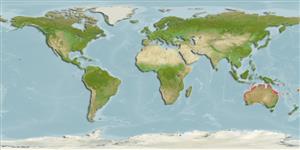Teleostei (teleosts) >
Kurtiformes (Nurseryfishes, cardinalfishes.) >
Apogonidae (Cardinalfishes) > Apogoninae
Eponymy: Wilhelm Peter Eduard Simon Rüppell (1794–1884) was a German collector. [...] (Ref. 128868), visit book page.
More on author: Günther.
Environment: milieu / climate zone / depth range / distribution range
Ecology
Marine; brackish; reef-associated; depth range 0 - 10 m (Ref. 90102). Subtropical; 11°S - 35°S
Western Central Pacific: Indonesia to northern Australia (including Western Australia) and New Guinea.
Length at first maturity / Size / Weight / Age
Maturity: Lm 4.7, range 5 - 4.9 cm
Max length : 12.0 cm TL male/unsexed; (Ref. 9710)
Inhabit inshore reefs and estuaries (Ref. 9710). Occur in groups in weedy areas (Ref. 9710). Nocturnal species (Ref. 7300).
Are mouthbrooders. The male is usually responsible for incubating the eggs (Ref. 240). Males brood from 50 to 230 fertilised eggs for about two weeks until hatching (Ref. 35252). Distinct pairing during courtship and spawning (Ref. 205).
Paxton, J.R., D.F. Hoese, G.R. Allen and J.E. Hanley, 1989. Pisces. Petromyzontidae to Carangidae. Zoological Catalogue of Australia, Vol. 7. Australian Government Publishing Service, Canberra, 665 p. (Ref. 7300)
IUCN Red List Status (Ref. 130435: Version 2024-1)
Threat to humans
Harmless
Human uses
Tools
Special reports
Download XML
Internet sources
Estimates based on models
Preferred temperature (Ref.
123201): 22.3 - 28.6, mean 26.7 °C (based on 416 cells).
Phylogenetic diversity index (Ref.
82804): PD
50 = 0.5000 [Uniqueness, from 0.5 = low to 2.0 = high].
Bayesian length-weight: a=0.01288 (0.00567 - 0.02929), b=3.10 (2.92 - 3.28), in cm total length, based on LWR estimates for this Genus-body shape (Ref.
93245).
Trophic level (Ref.
69278): 3.5 ±0.50 se; based on food items.
Resilience (Ref.
120179): Low, minimum population doubling time 4.5 - 14 years (Fec = 50).
Fishing Vulnerability (Ref.
59153): Low vulnerability (10 of 100).
Nutrients (Ref.
124155): Calcium = 81.3 [36.1, 179.3] mg/100g; Iron = 0.868 [0.442, 1.734] mg/100g; Protein = 19.7 [18.4, 20.9] %; Omega3 = 0.187 [0.091, 0.383] g/100g; Selenium = 10.9 [4.2, 24.7] μg/100g; VitaminA = 35.6 [8.3, 164.3] μg/100g; Zinc = 1.28 [0.73, 2.06] mg/100g (wet weight);
